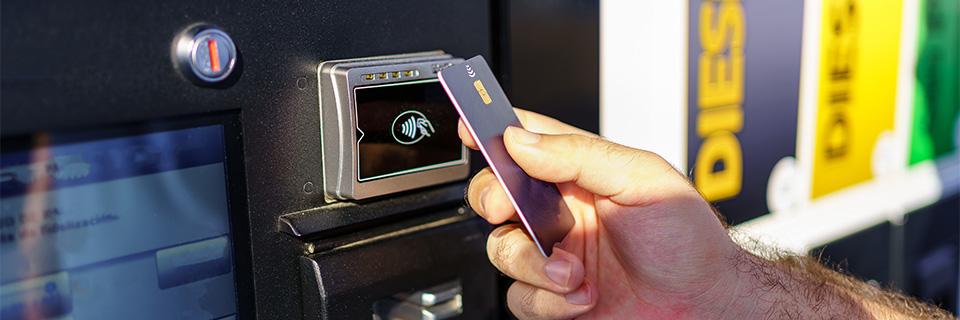
Studies show that for every dollar the average American trucking company earns, it spends 95.2 cents on operating costs.
That leaves a profit of only … 4.8 cents. Those are dangerously thin margins.
Whether you’re an owner-operator, or the head of a trucking fleet, you need to save money wherever you can, particularly on diesel fuel. And not just money in your pocket today, but savings that carry over month to month and year to year.
Any fuel card program worth its salt should save your company thousands of dollars a year. Membership to a fleet fuel card can help generate savings for carriers of any size.
In other words, it’s certainly worth your investment.
In this article, we’ll explore the ROI of fuel cards and how you can calculate long-term savings for your trucking business.
Fuel Cards: Maximizing Fuel Savings
Drivers carry fuel cards with them while they’re on the road to pay for fuel and other authorized purchases. Fuel cards are popular for owner-operators, but they can also be beneficial for all kinds of fleets. By using a fuel card within a designated fuel network, you’ll likely see significant savings.
But do these benefits last over time?
Can a Fuel Card Save You Money Over Time?
Suppose you have a small fleet of four trucks, each consuming around 1,500 gallons of fuel per month. If your fuel card provides an average discount of $0.20 per gallon, that adds up to $300 in savings per truck per month, or $14,400 in annual fuel savings across your fleet.
Over the years, these savings will compound, allowing your company to attend to other critical areas like maintenance, payroll, and expansion.
Beyond the raw discounts, some fuel card programs also offer incentives based on volume and consistent usage, meaning that as your fleet grows, so do your savings.
Is a Fuel Card Worth Your Time and Effort?
Nothing in life comes free. This is particularly true in the transportation industry. To maximize the benefits of a fuel card, you’ll need to take some strategic steps and avoid some common pitfalls:
- Plan Fuel Stops Wisely: Fuel cards work best when drivers fuel up within the designated network. Good fuel card programs have a wide network, but you’ll still need to plan your trips to ensure your drivers are stopping at in-network stations.
- Consider Associated Fees: Some fuel cards charge transaction fees, out-of-network fees and even in-network swipe fees (e.g., $0.50 per transaction). Make sure to factor these costs into your overall savings calculations.
- Encourage Compliance Among Drivers: Do your drivers understand the importance of using the fuel card at approved locations? Set company-wide policies to help enforce compliance.
Is a fuel card program worth this time and effort? Remember that a small fleet can reap nearly $15,000 in savings per year. But if this amount isn’t enough, consider additional advantages of fuel cards.
Additional Perks: What Else Can Fuel Cards Offer Me?
Fuel cards provide more than just discounts at the pump. Here are some additional perks you can expect with a great fuel card:
- Fuel reports: Access detailed reports for greater visibility into the spending habits of your fleet.
- Security: Set spending limits, restrict purchases to specific times and fuel types, and protect against fraud (with features like Card Lock from RTS Pro).
- Other discounts: Receive tires and maintenance discounts, equipment savings, in-store savings, and more.
What Saves Me More Money: A Fuel Card or a Credit Card?
If the above perks sound like those of a credit card’s cash back program, you aren’t entirely wrong. But you’ll typically want to go with a fuel card, especially in the long term.
Need convincing? Take just two examples:
- Suppose you use a business credit card with a standard 1.5% cashback on fuel purchases. If you spend $15,000 per month on fuel, that comes out to $225 in cashback. However, a fuel card offering $0.20 per gallon in discounts on 7,500 gallons would save you $1,500, a significantly better deal.
- Credit cards often lack the specific security features of fuel cards, meaning there’s a higher risk of unauthorized spending. A fuel card allows you to limit purchases to specific types of fuel, during specific times and at specific locations, ensuring that every dollar spent is directly supporting your business.
Substantial Long-Term Fuel Card Savings
Fuel costs are one of the biggest expenses for any trucking company. Using a fuel card, especially within a designated fuel network, can lead to significant long-term savings. In our uncertain economic environment—with retail fuel prices fluctuating every day—trucking companies should take advantage of discounted rates however they can.
RTS offers three distinct fuel card options to meet the needs of owner-operators and fleet managers. In addition to substantial savings at Pilot Flying J stations nationwide, our exclusive RTS Plus network includes discounts at hundreds of additional fuel stops, including Speedway, Circle K, Casey's and more.
No matter what fuel card you decide on, we hope you agree that they’re an easy way to create lasting value for your trucking business.
To learn more about RTS, contact a representative today.